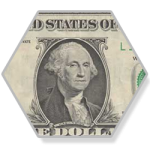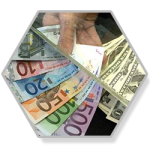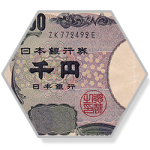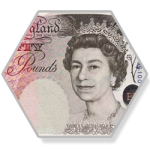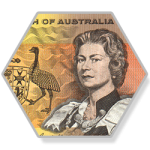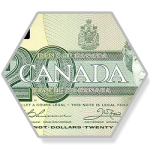Trading Assets
Comprehensive Exposure to the Markets with Valour
An Introduction
When you are trading FX Derivatives, you will need to select an underlying asset to trade on. At Valour, we are constantly looking to broaden our range of tradable assets, thus enabling users to diversify their trades. We have a wide range of index options from to offer, each containing a diverse range of assets from the various market classes. Here’s a quick look at the 4 broad asset classes we offer:
Forex
Forex, or the foreign exchange market, is one of the most fast-paced markets around. What used to be dominated by large financial institutions, central banks and hedge funds is now accessible to everyone thanks to the advent of the internet. According to the Bank for International Settlements, as of 2016, the average daily turnover in global foreign exchange markets is estimated at $5.09 trillion. By far the largest market in the world, the forex market provides plenty of opportunities for traders to make profits. Valour provides traders with a wide range of major, minor and exotic currencies.
Metals
When it comes to metals, it is perhaps best to start with the most recognizable of them all: Gold. Gold is a precious metal unique for its durability (it being entirely resistant to rust or corrosion), malleability and ability to conduct heat and electricity. Gold is traded 24 hours a day, nearly 7 days a week. Other precious metals include Silver (XAG), Platinum (XPT) and Palladium (XPD). Compared to precious metals, base metals are used more widely in commercial and industrial applications. They include aluminum, copper, lead and nickel. Valour offers a wide range of both precious metals and base metals as underlying assets.
Stocks
Stocks are a common occurrence in nearly any investment portfolio. In simple terms, stock is a share in the ownership of a company, and it represents a claim on the company’s assets and earnings. The more stock you acquire, the larger your ownership stake in your company of choice becomes. Valour provides you with stock index options from all over the globe, including the powerhouses DAX (Frankfurt Stock Exchange), MerVal (Buenos Aires Stock Exchange) and S&P TSX Composite (Toronto Stock Exchange).
Commodities
Both historically and in modern times, commodities markets have had a great economic impact on nations and people. Energy commodities such as Crude Oil, for example, are closely monitored by countries, corporations and consumers. Valour provides options for two categories of commodities: Energy and Agriculture.
Energy commodities consists of WTI Crude Oil, Brent Crude Oil, Unleaded Gasoline and Natural Gas. Agriculture commodities consist of Cocoa, Corn, Cotton, Soya Bean, Sugar and Wheat.
Why Multi Asset Derivatives?
What forms the core of multi asset options is the fact that it is made up of different elements which operate independently of one another. There are two reasons why a multi asset option will beneficial to you as a trader:
Firstly, a multi-asset strategy adopts a risk factor-based approach to asset allocation, allowing for the generation of capital grown with lower volatility than traditional allocations.
Secondly, having multiple asset options will increase the availability of liquidity for short term options due to its diversity. This will lead to more trading opportunities as a broader scope of market fundamentals will affect the multiple underlying assets instead of only a single asset.
At Valour, we have a total of 13 index options from 3 different categories. They are:
Location-based Multi Asset Derivatives: Stocks and Forex
Trading FX Derivatives on a combination of stock index options and currencies can be a simple and effective means of generating financial rewards. Valour provides traders with the option to trade on stock index options and currencies from around the globe, including the Asia Pacific region, Europe and the Americas. The following multi asset options are categorized geographically:
This index allows you to tap into one of the fastest growing markets in our world today. We have stock index options from Hong Kong, China, and Japan, all three of which are key trading centers in the Asia-Pacific region. The major indices included are:
HIS (Hang Seng), a stock market index that represents the 45 largest companies being traded on the Hong Kong stock market today.
SSEC (Shanghai Composite), a capitalization-weighted index which tracks the daily price of all A-shares and B-shares listed on the Shanghai Stock Exchange.
N225 (Nikkei 225), the stock market index for the Tokyo Stock Exchange which offers a price-weighted average of the top 225 components trading on the respective stock market.
Also in the ASIA PACIFIC Index, are three major currencies that make up the rest of the underlying assets available under this multi asset option. They are the Yen (JPY), Australian Dollar (AUD) and New Zealand Dollar (NZD).
This index focuses on the powerhouses of the region: Germany, France, Switzerland and Britain. These four countries make up a few of the leading economies around the globe today. The major indices included are:
DAX (Frankfurt Stock Exchange), a German-based stock index which includes 30 of the main German companies that are traded on the Frankfurt Stock Exchange.
FTSE (London Stock Exchange), an index owned by both the Financial Times and London Stock Exchange and is managed by the FTSE Group, an internationally recognized leading stock index within the trading community.
SMI (Swiss Stock Exchange), an index with 20 components which stretch across a wide range of industry sectors including finance, food, pharmaceuticals and telecommunication.
CAC40 (Pan-European Stock Exchange), a benchmark stock market index in France which comprises of 40 of the largest organizational stocks out of the 100 largest organization market capitalizations.
The three major currencies which make up the EUROPE Index are the Euro Dollar (EUR), British Pound (GBP) and Swiss Frac (CHF).
This index focuses on a hybrid of assets from countries within North and South America, including the United States of America, Canada, Brazil and Argentina. The major indices included are:
MerVal (Buenos Aires Stock Exchange), a basket weighted index selected according to participation in the Buenos Aires Stock Exchange.
BVSP (BM&F Bovespa Stock Exchange), an index created through the merger of the Sao Paulo Stock Exchange and the Brazilian Mercantile and Futures Exchange. BM&F Bovespa is officially the eighth largest stock exchange in the world.
S&P TSX Composite (Toronto Stock Exchange), a headline index for the Canadian equity market and also the broadest in the S&P/TSX family.
NASDAQ Composite, a market capitalization-weighted index of approximately 3, 000 common equities listed on the NASDAQ stock exchange.
S&P 500, an American based, free-float capitalization weighted index managed by Standard & Poor’s, one of the leading financial service firms in the United States.
The three major currencies which make up the AMERICAS Index are the US Dollar (USD) and Canadian Dollar (CAD).
Industry-based Multi Asset Derivatives: Metals, Commodities and Exotics
It is becoming more common for traders to move towards metals, commodities and exotics trading due to the increasing frequency of market instability. Valour offers traders a wide selection of some of the most popular commodities around the world, a broad range of metals, as well as a large selection of exotics to choose from. The following multi asset options are categorized by industry:
METALS Index
This index can is a hybrid of two sub-divisions: precious metals and base metals, and is weighted based on global production volume and trade liquidity averaged over the preceding five-year period. Precious metals such as gold and silver have been recognized as valuable throughout history. Gold, for example, is regarded as the world’s oldest traded commodity and is valued as a secure store of wealth. In addition to the precious metals, this index also consists of base metals such as aluminum, copper, lead and nickel.
The precious metals in this index are: Gold (XAU), Silver (XAG), Platinum (XPT) and Palladium (XPD).
The base metals in this index are: Aluminum (99.5% purity), Copper (Grade A Cathode), Lead (99.97% purity), Nickel (melting grade), Tin (99.85% purity) and Zine (99.995% purity).
The underlying assets of the METALS Index are US Dollar denominated, and the unit of measure used is the troy ounce (t oz) for all precious metals and metric ton (MT) for all base metals. The exception to this is copper, which is measured in pounds (lb).
COMMODITIES Index
For traditional stock market traders, trading commodities has been prioritized during times of market volatility. One of the most popular commodities is Brent Crude, a type of crude oil which is extracted from the North Sea and is used as a price benchmark for approximately two-thirds of all the crude oil traded across the globe. The commodities in this index can be divided into two main groups:
Energy, consisting of WTI Crude Oil, Brent Crude Oil, Unleaded Gasoline and Natural Gas.
Agriculture, consisting of Cocoa, Corn, Cotton, Soya Bean, Sugar and Wheat.
The underlying assets of the COMMODITIES Index are US Dollar denominated.
EXOTICS Index
An exotic currency, in forex terms, refers to thinly-traded currencies which are illiquid and lack popularity in the sense that it does not stimulate consistent market activity. This does not denote, however, that exotic currencies are weak or undervalued. The EXOTICS Index allows traders to trade on these volatile currencies without exposing themselves to the risks typically associated with such currencies. By establishing a broad based basket and consolidating liquidity, greater activity and fluctuations are generated, allowing for profit yields. It also doubles as a form of portfolio diversification from major currencies trading.
Underlying assets in this index include: the Turkish Lira (TRY), Swedish Krona (SEK), Norwegian Krone (NOK), Danish Krone (DKK), South African Rand (ZAR), Saudi Riyal (SAR), Hong Kong Dollar (HKD), Singapore Dollar (SGD), Offshore Chinese Yuan (CNH) and Indian Rupee (INR).

